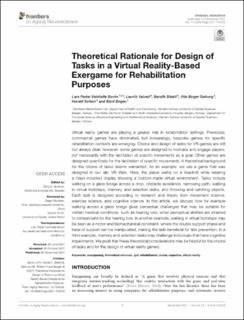| dc.contributor.author | Bovim, Lars Peder Vatshelle | |
| dc.contributor.author | Valved, Lauritz | |
| dc.contributor.author | Bleikli, Bendik | |
| dc.contributor.author | Geitung, Atle Birger | |
| dc.contributor.author | Soleim, Harald | |
| dc.contributor.author | Bogen, Bård Erik | |
| dc.date.accessioned | 2022-01-27T09:17:27Z | |
| dc.date.available | 2022-01-27T09:17:27Z | |
| dc.date.created | 2021-11-26T17:29:47Z | |
| dc.date.issued | 2021 | |
| dc.identifier.citation | Bovim, L. P. V., Valved, L., Bleikli, B., Geitung, A. B., Soleim, H., & Bogen, B. (2021). Theoretical Rationale for Design of Tasks in a Virtual Reality-Based Exergame for Rehabilitation Purposes. Frontiers in Aging Neuroscience, 13:734223 | en_US |
| dc.identifier.issn | 1663-4365 | |
| dc.identifier.uri | https://hdl.handle.net/11250/2879885 | |
| dc.description.abstract | Virtual reality games are playing a greater role in rehabilitation settings. Previously, commercial games have dominated, but increasingly, bespoke games for specific rehabilitation contexts are emerging. Choice and design of tasks for VR-games are still not always clear, however; some games are designed to motivate and engage players, not necessarily with the facilitation of specific movements as a goal. Other games are designed specifically for the facilitation of specific movements. A theoretical background for the choice of tasks seems warranted. As an example, we use a game that was designed in our lab: VR Walk. Here, the player walks on a treadmill while wearing a head-mounted display showing a custom-made virtual environment. Tasks include walking on a glass bridge across a drop, obstacle avoidance, narrowing path, walking in virtual footsteps, memory, and selection tasks, and throwing and catching objects. Each task is designed according to research and theory from movement science, exercise science, and cognitive science. In this article, we discuss how for example walking across a glass bridge gives perceptual challenges that may be suitable for certain medical conditions, such as hearing loss, when perceptual abilities are strained to compensate for the hearing loss. In another example, walking in virtual footsteps may be seen as a motor and biomechanical constraint, where the double support phase and base of support can be manipulated, making the task beneficial for falls prevention. In a third example, memory and selection tasks may challenge individuals that have cognitive impairments. We posit that these theoretical considerations may be helpful for the choice of tasks and for the design of virtual reality games. | en_US |
| dc.language.iso | eng | en_US |
| dc.publisher | Frontiers Media | en_US |
| dc.rights | Navngivelse 4.0 Internasjonal | * |
| dc.rights.uri | http://creativecommons.org/licenses/by/4.0/deed.no | * |
| dc.title | Theoretical Rationale for Design of Tasks in a Virtual Reality-Based Exergame for Rehabilitation Purposes | en_US |
| dc.type | Peer reviewed | en_US |
| dc.type | Journal article | en_US |
| dc.description.version | publishedVersion | en_US |
| dc.rights.holder | © 2021 Bovim, Valved, Bleikli, Geitung, Soleim and Bogen. | en_US |
| dc.subject.nsi | VDP::Matematikk og Naturvitenskap: 400::Informasjons- og kommunikasjonsvitenskap: 420 | en_US |
| dc.subject.nsi | VDP::Medisinske Fag: 700::Helsefag: 800 | en_US |
| dc.source.volume | 13 | en_US |
| dc.source.journal | Frontiers in Aging Neuroscience | en_US |
| dc.identifier.doi | 10.3389/fnagi.2021.734223 | |
| dc.identifier.cristin | 1959982 | |
| dc.source.articlenumber | 734223 | en_US |
| cristin.ispublished | true | |
| cristin.fulltext | original | |
| cristin.qualitycode | 1 | |

